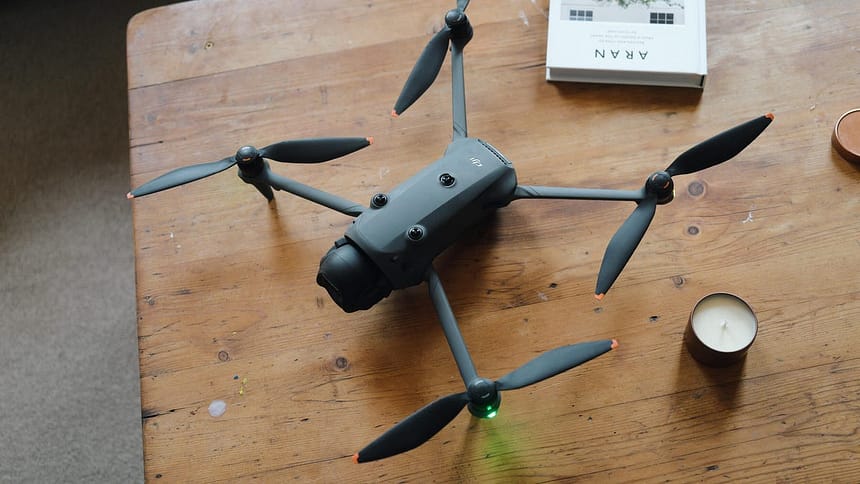DJI has remained the leader in camera-equipped drones since the company’s Phantom series launched in 2013 and its latest model, the Mavic 4 Pro, will only cement its position as the go-to option for aerial filmmakers. From its innovative new gimbal system to its impressive zoom skills and image quality, the Mavic 4 Pro offers an extremely powerful package for amateurs and professionals alike to capture stunning imagery from the air.
I’ve flown the Mavic 4 Pro and I’m impressed with its image quality from all of its cameras, the new “infinity gimbal” and the drone’s overall ease of use.
But it asks a lofty price in return, with the new drone starting at £1,879 in the UK and the Fly More Creator Combo that includes three batteries and the company’s new RC Pro 2 controller (as reviewed) costing a princely £3,209. At launch, the Mavic 4 Pro will not be available in the US. I asked DJI about this and a company spokesperson had this to say:
“The DJI Mavic 4 Pro will not be available for sale in the US upon its global launch on May 13. Like many global companies, we have had to adjust our market strategy as local conditions and the industry environment have evolved. While we do not have a timeline for when we can introduce the product to the US market, we are closely monitoring the situation and actively exploring every possible solution.”
For reference, those UK prices convert to $2,499 and $4,268, respectively.
The Fly More Creator Combo includes the drone, three batteries with fast charging cradle and the controller with built-in LCD display.
Its price puts the drone out of range for those of you simply wanting to take your first steps into capturing aerial footage to send to your friends on Instagram. Instead, the Mavic 4 Pro is squarely aimed at more serious content creators as well as video production professionals who want an extremely capable flying camera but don’t quite want the expense — and setup hassle — of DJI’s more cinema-focused Inspire series.
DJI Mavic 4 Pro: New gimbal, new cameras
At the heart of the Mavic 4 Pro is a redesigned gimbal. Instead of a square camera unit sitting below the drone, the new “Infinity Gimbal,” as DJI calls it, is more of a sphere that sits right on the front. It can freely shoot forward, down, to the sides and even upward. It offers a much wider range of motion than previous DJI drones, and it opens more creative shooting options while flying.
I especially enjoyed shooting footage looking upward as the sun came from behind the clouds. At slow speeds, the propellers were not visible in frame, although I found that when I flew faster, the gimbal’s adjusted position made propeller movement more noticeable in my footage.
The new Infinity Gimbal allows for a much greater range of movement than was possible on previous models.
The gimbal houses three cameras: a main camera with a 4/3-size CMOS sensor and a 28mm equivalent field of view, a medium telephoto camera with a 70mm equivalent focal length and a longer telephoto camera with a 168mm equivalent focal length for very zoomed-in shots. The main camera offers resolutions up to 6K at 60 frames per second and can take stills up to 100 megapixels in size in DNG raw format.
Its relatively large sensor size allows it to capture more light, allowing for better dynamic range (DJI promises “up to” 16 stops) and better image quality in low light. In practice, I found video and stills from this camera looked superb, with crisp details, even exposures and accurate colors. The variable f/2 to f/11 aperture allows for narrow aperture shots, turning bright points of light — like the sun — into attractive 10-point star bursts, which looked amazing. Stills shot in raw were sharp with lots of latitude for deep editing in Adobe Lightroom.
The variable aperture allowed me to create an authentic 10-point star on this still image of the sun peeking out from behind a cloud.
At 70mm zoom, footage still looks pin-sharp, and I even found the 168mm zoom lens to provide great-looking video as well. I wasn’t impressed with the zoom on the previous Mavic 3 Pro, finding it generally too low-quality to be usable for anything other than casual Instagram posts. The Mavic 4 Pro’s zooms are different beasts altogether, providing footage that looks good enough for all but the most demanding of commercial clients.
Taken with the 70mm lens, this image remains pin sharp. By shooting in DNG raw I was able to adjust the white balance afterward to create a pleasing, warmer tone.
Even using the longest 168mm zoom lens, images still look clear and sharp.
Better yet, all three cameras allow you to shoot at 4K resolution in 10-bit D-Log color profiles, which is useful for those who want to add your own cinematic color grades to your aerial footage.
DJI Mavic 4 Pro: Flying, controller and battery life
The Mavic 4 Pro flies like any other drone from the company’s back catalogue, so those of you who’ve spent any time with a previous model will already be familiar with the controls. While the drone is aimed more at professionals and enthusiastic amateurs, it’s simple enough to learn even if this is your first foray into aerial photography.
To help beginners — as well as helping the more reckless among you — there is the usual array of sensors on all sides to help it avoid colliding with obstacles in front, behind, above or below. These continue to work as well as I found them on previous models, consistently identifying — and avoiding — potential objects including trees, branches, power lines and people. Basically, anything that it could smash into.
The controller is comfortable to hold while the huge display offers a bright, clear view as you fly. I much prefer using this simply having to connect my phone to use as the viewfinder.
There’s also a slew of intelligent flight modes, including object tracking and programmable flight plans, all of which are pretty much the same as on DJI’s other models.
The Mavic 4 Pro can be bought with the company’s new RC Pro 2 controller, which has its own built-in adjustable 7-inch display. It’s basically like slapping an iPad Mini onto the controller, and it means you don’t have to mess with trying to hook your phone up to use as the display. I really like it and found the big, bright screen a great way to monitor my footage while the drone was in the air. The controller has various dedicated controls for using the cameras along with a new HDMI out port for hooking up an external monitor — handy if your project director, client or just your mate wants a better view of what you’re doing.
In terms of flying time, DJI claims you’ll get up to 51 minutes of flight from a fully-charged battery. That’s a solid step up over the 46 minutes of promised flight time on the last Mavic Pro, but in reality, you can expect that number to be quite a bit lower. I flew mostly in moderate winds and at higher speeds, and generally found that I achieved flight times closer to 30 minutes. Still, that’s not a bad amount of airtime, especially if you opt for the Fly More combo, which comes with three batteries and a 100-watt fast-charger that juices them back up extremely quickly.
With sensors on all sides, the Mavic 4 Pro can avoid obstacles in any direction.
The drone weighs 1,063 grams (2.3 pounds), so all fliers in the US will need to register themselves — and the drone — with the FAA (assuming you can buy one at all, that is), whether you plan to use it commercially. Drone laws differ significantly between countries (and even within states in the US), so be sure you check your local laws before taking flight and ensure you always operate a drone safely.
DJI Mavic 4 Pro: Should you buy it?
The Mavic 4 Pro’s upgrades over the previous Mavic 3 Pro are significant. The newly designed gimbal allows for shots simply not possible with other models, while the overall image quality — especially from the zoom lenses — is a big step up. While its high price means this isn’t a drone for those of you simply wanting to add some aerial excitement to your TikToks, the Mavic 4 Pro is a superb option for video professionals who want to add some truly cinematic drone footage to their image-making arsenal. That is, if you live somewhere, you can buy it.





